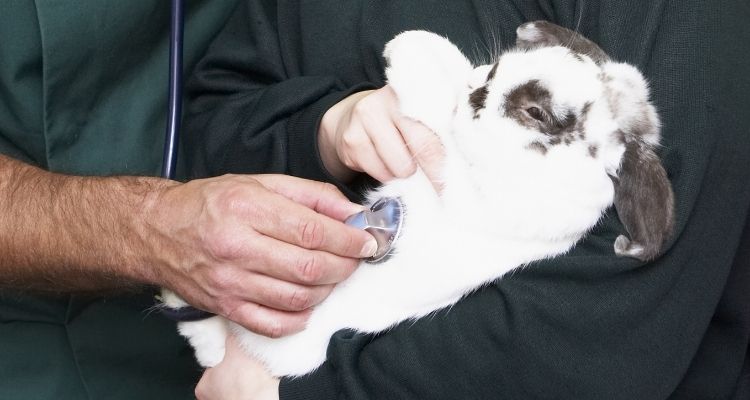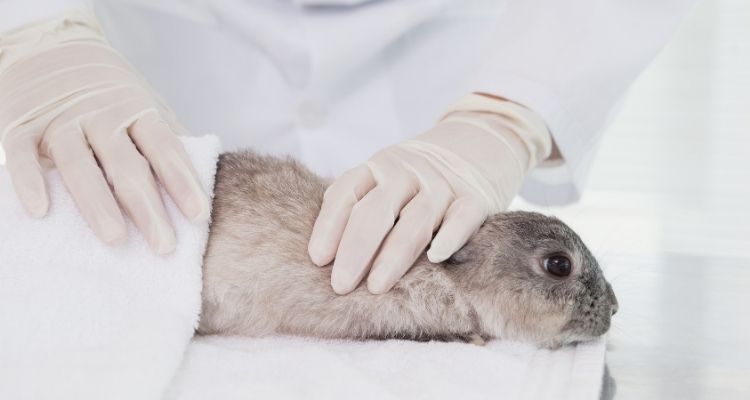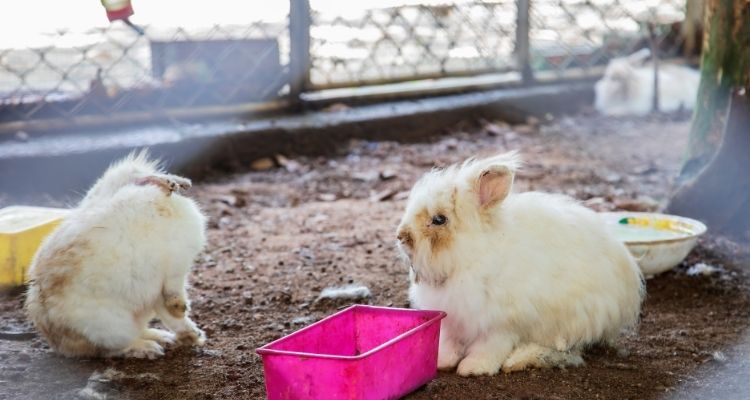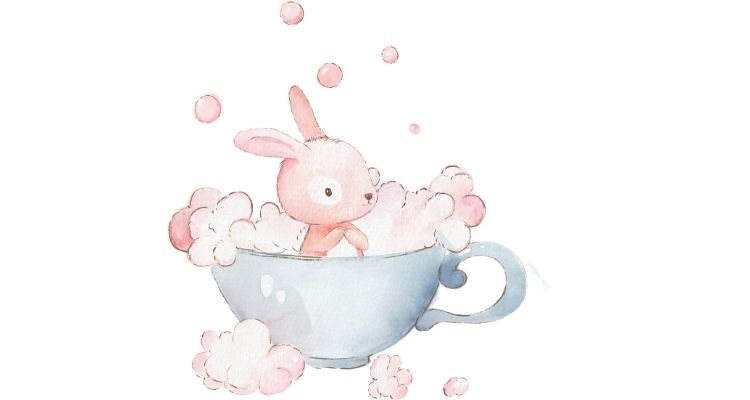Unlike dogs, rabbit’s spend a good portion of their day cleaning themselves. It’s much better to assist rabbits by making sure their enclosures are clean and their litter boxes are emptied daily rather than worrying about giving them a bath.
Some pet rabbits may need some help from time to time, especially as they grow older. There are generally two key instances where you may need to interfere in your pets’ hygiene habits – when they get stuff on them that they shouldn’t try to clean off themselves, or if they have a build-up of excretory products on their rear end.
Bunnies do not need routine washing. Regular bathing, both with or without shampoo, deprives the rabbit’s coat of its natural oils, those that serve to help to keep the rabbit’s coat healthy. Companion rabbits will most likely clean and groom one another as well.
Associated Reading: Rabbit Grooming – A Beginners Guide
Can You Give Rabbits a Bath? What the Experts Say

The ARBA, also known as the American Rabbit Breeders Association and the BRC, British Rabbit Council, advise that bathing is required as part of care for your rabbit.
The House Rabbit Society specifically cautions against giving full body baths to rabbits, indicating that the trauma of being immersed in water may result in shock and lead to death.
Bathing a rabbit may be dangerous, due to the fact that they have a tendency to panic in water. If they thrash about, they might possibly break a limb or their vertebrae.
Wet rabbits can easily catch a chill and experience pneumonia, respiratory system infections, hypothermia, as well as other dangerous and potential life threatening health conditions.
Here are a number of potential complications from bathing bunnies:
Shock
Rabbits are rather delicate beings. Any sort of unforeseen factors can cause a rabbit to enter into shock and even suffer a heart attack from fright. Rabbits may be truly scared stiff particularly in unusual or new circumstances. This can result in death, so please be careful.
When a rabbit enters into shock from fright, their body temperature starts to plummet and their body will begin to shut down. The signs and symptoms of shock normally include:
- Fast respiration rate
- Rapid heart beat
- Pale, white colored gums (as the blood is being sent to the vital organs)
- A body which is floppy and limp
- Cold ears
- Glazed eyes
If this should ever occur, regardless of whether it be from attempting to give your rabbit a bath or under other conditions, you must instantly protect your rabbit by wrapping them in a soft towel. This will help keep them warm.
Pat your rabbit to soothe them as much as you can. Dry your rabbit off and take the rabbit aside from any unnecessary noise or disturbances that could increase their stress.

If your rabbit’s vet is close by, call to schedule and urgent appointment as soon as possible. If the veterinarian is a lengthy commute, phone and seek advice. Car Travel can be are extremely upsetting for rabbits, so a lengthy drive could very well end up aggravating your rabbit’s condition.
With luck, the rabbit should begin to recuperate over the next couple of hours and days. Sadly shock is quite often incurable for rabbits.
Hypothermia
Rabbits have very thick fur to protect them and keep them warm. Even if you try to dry your rabbit after the bath, it’s difficult to be completely thorough. When fur gets water-logged it requires a surprisingly long time to completely dry.
Rabbits primarily use their ears to regulate their body temperature levels. Having moistened fur for any extended period of time interferes with their capacity to self regulate their body temperature. This poses a danger to the rabbit of developing a dangerously low body temperature,also known as hypothermia.
If your rabbit has hypothermia their entire body will weaken. Hypothermia can easily become fatal in rabbits in the event that you overlook the signs. Signs and symptoms to watch out for include things like:
- Sitting with no movement, or moving slowly and gradually.
- Feet and ears feeling cold to the touch and appearing pale in color.
- Shallow respiration (breathing).
- Weak pulse.
- Non-responsive, or does not move or react to you whenever you make an effort to engage with them.

It is very important to get in touch with your vet to set up an urgent appointment if you feel your rabbit has developed hypothermia. In the interim, don’t stand by and wait before you attempt to bring your rabbit’s body temperature level back to normal.
At this point in time, you will want to start externally warming your rabbit by:
- Wrapping them in a soft towel and snuggling them.
- Carrying your rabbit to a warmer area of the home.
- Ensuring your rabbit has been thoroughly dried and does not remain wet.
- You can position your bunny nearby a heating pad if you have one. Ensure it is on the lowest heat setting. If you don’t have a heating pad, wrap a hot water bottle in a soft towel and place it next to your rabbit.
- Provide luke-warm water for your rabbit to drink.
Injuries
Rabbits also have the potential to injure themselves during a bath. The slick surface like the bottom of a bath or basin is slippery for rabbits feet.
Rabbits also have very strong hind legs. They could kick strong enough that they twist or fracture their spine causing paralysis if they are very scared. Despite the strength of their hind legs, rabbits have a much weaker spine.
Skin Irritation

Rabbit skin is sensitive and very delicate. Bathing can easily irritate a rabbits skin and cause a rash or infection. The water strips away the natural oils on your rabbits body and leaves them with dry, unprotected skin.
When it is wet, a rabbit’s skin is also more easily damaged. A small cut on wet skin could result in a much more painful and serious wound.
If anything such as this happens to your bunny, you should immediately seek help and advice from your vet.
Water in Your Rabbits Ears or Up Its Nose
Water in rabbits ears can potentially lead to future ear infections. Similarly, if a rabbit get’s water up their nose, they are in danger of developing a respiratory infection. If they receive medical attention quickly, rabbits can recover from from these infections.
Rabbits are experts at hiding when they feel sick, so you’ll need to watch to make sure their behavior and appetite are normal.
When You May Have to Bathe Your Rabbit

Urine Scalding
Rabbits generally urinate several times a day. Rabbit urine is caustic and highly concentrated. It should be allowed to soak into a litter box or bedding deep enough to create a barrier between your bunny and his waste.
Rabbits develop a condition called urine scalding or wet tail when urine is allowed to saturate their fur. Signs of urine scalding are red, irritated skin and loss of hair which may run up the length of the rabbits belly.
Some dribble of urine is normal and a little dribbling should not result in urine scalding.
Fecal Matter
Rabbits produce two kinds of droppings; either hard, round fecal pellets or soft, mucus-covered bunches of dark pellets known as cecotropes.
Fecal pellets are primarily made of indigestible fiber. This is what you commonly see as waste in bunny’s bedding or litter box.
Cecotropes, sometimes called night droppings because rabbit’s generally produce them in the evening. You may never even see cecotropes in your rabbit’s bedding because rabbits reingest these.
Both types of droppings can get caught in even the cleanest rabbit’s fur. Droppings found in bunny’s fur should be bathed away as quickly as possible.
Rabbits who often have dirtying of their back end with caecotrophs and/or urine, may require frequent bottom washes. Left uncleaned, fecal covered and urine soaked fur can lead to a fatal condition known as myiasis or fly strike.
Clean your rabbits enclosure straight away, if you see flies hanging around. Flies are attracted to the waste odor and the warmth and moisture of your rabbits back end are perfect conditions for fly larva. Check your rabbit thoroughly for larva and consult your rabbit veterinarian.
These rabbits often have underlying medical conditions (which may be numerous), meaning they are not keeping themselves clean. Potential reasons may include:
If your vet recommends for health reasons you need to bath your rabbit, then get someone else to help you so one person can keep a firm hold of the rabbit whilst the other person does the bathing.
How to Bathe a Rabbit

If your rabbit is really dirty, and you have absolutely no other option, then you may ultimately have to give them a bath.
Generally it is not necessary to wet the whole rabbit. It is important to only wet the part of your rabbit that needs cleaning, for example, their butt or hind leg. Butt baths are common for rabbits.
To do this, simply dip their leg into a bucket of lukewarm water and remove it again quickly. Ensure any soap is thoroughly washed away. If any soap is left, it can irritate the skin.
Many human, dog, and cat shampoos contain chemicals that are toxic to rabbits. Make sure you are using a rabbit safe cleanser. If you can’t tell whether the product is safe for rabbits by reading the label or bottle, err on the side of caution and don’t use it.
Consider also if you really need shampoo or a cleaning agent. If your rabbit has urine on its hind quarters (fairly common in male rabbits) this can usually be rinsed away with water on the surface area of the fur. There is no need for a thorough cleaning with shampoo.
Make sure that you have a non-slip rubber mat or towel on the bottom of the bath or sink. You could also try resting a grate in the bottom for the rabbit to sit on, so they are not sitting in water. This helps the rabbit to grip so they are less likely to panic and thrash around, as mentioned above. Use warm water and constantly check to ensure it isn’t getting hotter or colder.
Use a jug of water rather than a shower or handheld hose. Start at the rabbits rear end and again, only clean the areas of your bunny that are absolutely necessary.
If you are only washing the rabbit’s back end, then after gently placing them into the sink/bowl/bath, get your assistant to lift their front end up by placing a hand under their chest and one on top, so only their back end is in the water, and then wash their back end. When finished, gently lift the rabbit out and wrap them in a warm towel. Bathing should be done as quickly as possible so the rabbit doesn’t get too cold.
Rabbits who live outside will need to stay in at least overnight, and longer if it is cold outside to ensure they are totally dry and don’t go back outside when still damp. Unless absolutely necessary it is not advised to bath an outdoor rabbit in the winter months.
Use a hair dryer to dry your rabbits fur, but take great care not to overheat the rabbit. Only use a hair dryer for a short while before giving the rabbit a break, ensuring they are kept warm during breaks.
Dry Shampoo for Rabbits

You can spot-clean your rabbit with a barely damp or dry rag or paper towel.
One entirely safe way to bathe a bunny is the dry bath. Since you won’t place her in water, she’s less likely to freak out and won’t run the risk of injury or hypothermia. Chances are she may enjoy getting a dry bath.
Wad up a towel and put it in your lap then set your rabbit on top of the towel. Sprinkle some talc-free, cornstarch-based baby powder onto your rabbit and work it into her fur with your fingertips, concentrating on the soiled areas.
To your rabbit, this may feel like a massage. You can then use a soft bristle brush to sweep the baby powder and dirt from her fur you’re done.
Dying Your Rabbits Fur
It has been known for people to dye rabbit fur much like some breeds of dog. Rabbits have delicate skin and digestive systems. Absorption of any dye either through ingestion through grooming or via the skin may cause serious health issues for the rabbit.
There are no benefits for your bunny to dye its fur. Please don’t consider doing this. Ever.
A Final Thought
Avoid the point of having to consider giving your rabbit a bath by grooming regularly. The brushing sessions will provide some bonding time for both of you and give you a chance to check her body for abnormalities, her skin for parasites and her ears to make sure they are clean odor-free and dry.

